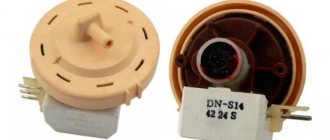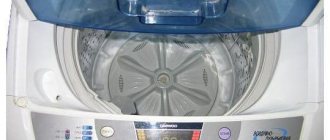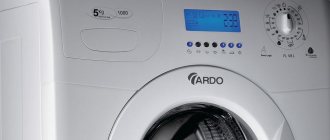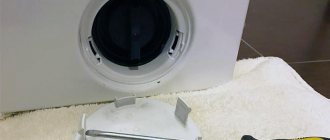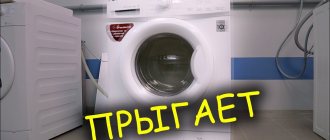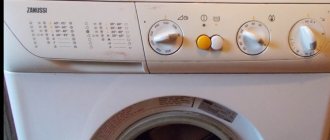An automatic washing machine (hereinafter referred to as AMA) is a complex piece of household appliance that periodically needs repair. This can happen at the most inopportune moment; in simple terms, a malfunction takes owners by surprise. For example, some owners of washing equipment are faced with a situation where the washing machine takes in water but does not wash. However, there is no need to panic. You just need to determine the cause of the breakdown and take certain measures accordingly.
Possible causes of malfunction
There are several “symptoms” that the machine is not washing. The main situations can be described as follows:
- there is water filling, but there is no subsequent rotation of the drum;
- water enters the tank, then the water drains and the motor stops, sometimes the display shows an error;
- The washer fills with water and then turns off.
Therefore, you need to carefully study what the reasons for this “behavior” of the machine are, and how to eliminate them so that the device continues to function.
Electric motor
Often it is enough to simply replace the motor brushes, although in some situations it is necessary to replace the entire part. In both cases, the part will have to be removed and then freed from the belt and sensors. You can remove the terminal on the brush using a screwdriver. You can remove the brush by using a plate. Similar actions are carried out with respect to the other brush. Next, the new brush is sent to the holder, pressed with a spring and secured.
Often the cause of a malfunction may be the lack of sufficient current for natural starting. In this case, you will need to replace the capacitor or rewind it. Sometimes the motor unit does not start due to overheating; in this case, water is collected, but washing is not. The reason is the launch of several washes in a row. Sometimes it’s enough to give the washer time to cool down.
If water is pouring in, but the drum does not rotate, there is no noise, then the problem is the combustion of the commutator motor. Along with this, the starting capacitor may also fail. On models equipped with a display, the corresponding lamp may light up. In any of these situations, a comprehensive engine repair or replacement will be required. The same goes for pumps that have stopped rotating.
Drum jammed
If the washer fills with water but the drum refuses to spin, the reason is usually that the program ended without spinning the laundry. Self-diagnosis traditionally consists of the following steps:
- checking the load (the size of the washing machine load, which can be small or large, in any case, uniform distribution of clothes throughout the compartment is required to maintain balance; if it is absent, the control module will fail);
- checking the belt (probably it has simply come off the engine, just open the door and turn the element by hand, free rotation and lack of resistance indicate it has fallen off);
- checking the washing cycle (you need to select the standard cycle and activate the device, it should fill with water, as a result the drum will turn over, if it is idle, you can talk about the breakdown of the brushes or the control module).
If none of the above steps helps, you should contact a service center.
The heating element is faulty
If there is no water heating, this is due to a breakdown of the heating element. The fact is that for normal operation it is enough to use cold water, because the heating element subsequently provides it with a normal temperature. If the heating element fails, you will not be able to solve the problem yourself, especially if an error message appears on the display.
The heating element itself is located under the drum. First you need to disconnect the elements from the terminals, and then use a multimeter to carry out diagnostics. Probes are placed at the element terminals. If it is working, the value will be in the range of 20-25 Ohms.
An important role is played by checking the temperature sensor located near the heating element. It is pulled out and disconnected from the plug. The multimeter is then used again with the resistance set to a higher level. The sensor will display readings from 20 to 50 ohms. If the sensor is working properly, the readings will decrease when you touch it. After this, you need to make sure that there are no situations such as combustion or blocking.
Damage to the water level sensor
In this case, the washing machine draws water, and then immediately drains it and refuses to wash. If the washing machine model is equipped with a display, it may display a pressure switch error. In all these situations, we are talking about problems with the pressure switch tube, which can fly off or become clogged. It is often subject to various damages. Sometimes the pressure sampling chamber becomes dirty, or the sensor fails. The bottom line is that the SMA is not able to determine the volume of water inside, so it drains and the engine stops. To solve the problem you need to blow out the tube.
Control module
A defect on the circuit board may interfere with the motor as the drum rotates. Since the main problem lies in the electrical part, in this case it is impossible to do without the services of a competent technician. Only an experienced expert will carry out diagnostics and testing of this element using a stand. After all, it is impossible to understand what happened by sight, especially if there are no traces on the parts and paths. Even if they are available, soldering of the board will be required, and this process is long and painstaking, and a person without experience and skills simply cannot cope with it.
Bearing wear
The rotation of the drum during use of the washing machine is carried out using a bearing, which reduces friction. This indicates the importance of these elements. However, due to their regular getting wet, breakdown can occur quickly. If the washer makes too much noise, they are to blame!
Practice shows that all this happens after about 10 years of operation of the unit. It is also worth noting that excessive noise may be a sign of a broken pump or motor, as well as shock absorbers and belt. The problem occurs during the spin cycle.
Wiring fault
If, after drawing water, the drum suddenly stops, and the display appears blinking or completely fades, the reason may lie in a breakdown of the electrical wiring. You can find wires that have burned out through a visual inspection, accompanied by ringing the basic elements of the circuit. The same approach will prevent short circuits.
Drive belt is faulty
If the device is equipped with a direct drive, this malfunction cannot occur, because The belt is simply missing. If the drive is different, you should start self-diagnosis from this point, because it is the most common reason for the machine taking on water and not washing.
So what can actually happen to a belt? There are quite a lot of reasons. It often falls off during transportation or wears out due to prolonged maintenance and needs to be replaced. In all SMAs where belt transmission and front loading are provided, the belt is located at the rear of the body. If it is vertical, the element is located behind the lid on the side. When removing it, there are usually no problems; unscrewing all the bolts is enough.
If the belt falls off, it is simply pulled out of the housing and then carefully inspected for breakages and defects. If they are present, the element is replaced. To put on a new belt, you need to place it on the engine, pull it up and over the pulley, and then slide it all the way on.
As for other reasons for the lack of washing when drawing water, they can be described as follows:
- the centrifuge is jammed if, for example, foreign objects appear between it and the tank in the form of a bolt, clamps, hose, accessories from things, etc.;
- the main board is broken (the fault can be determined by visual inspection, detecting blackening of the contacts or their groups);
- the pressure switch is out of order, it can overfill or underfill water, you just need to carry out diagnostics and repairs with replacement;
- the impeller is clogged due to foreign objects getting inside;
- the wiring has become unusable, in this case, after filling with water, the drum simply stands up and refuses to work;
- work in semi-automatic mode;
- penetration of air into the pump, failure to start certain modes.
These are not all the causes of breakdowns, but they are the main ones and deserve special attention.
Electronics problems
Washing machines with an intelligent type of control are “tied” to electronics. The entire system is subordinated and controlled by a control board, which issues commands to individual parts, coordinating the operation of the device. If a short circuit occurs somewhere, the unit loses connection with the components and delays the start of the machine.
The essence of such a message is similar to a manual timer. The only difference is in scale and technological content.
You can understand the cause of the malfunction by deciphering the error code displayed on the display of the washing machine.
If there is not enough voltage at the terminals of the electric motor or pump, at the intake valve coil or at the UBL circuit, then the board will not be able to start the exchange processes. The components will not receive the start signal and will not start working.
An electronic board is a complex and sensitive mechanism. It is almost impossible to diagnose it at home without special equipment and experience. The user can only visually check the block for burnt-out devices and “tracks”. So, there are problems with the controller if there are traces of fire or short circuit on the control panel in the form of dark spots, burning marks and melted elements.
It is better to entrust board diagnostics to professionals. If damage to the electronics is detected due to a short circuit, the unit will have to be replaced. The main thing is not to rush and eliminate the cause of the failure before connecting a new panel - otherwise the situation will repeat itself.
Often the cause of damage to the board lies in the incorrect operation of external structural parts included in the common electronic network. If the problem is not identified, the electronics will suffer again.
But the failure to start the washing machine does not always indicate serious problems with the motor, UBL or board. Often a banal violation of the conditions for proper operation of the washing machine leads to failure. Thus, equipment often does not respond to user commands for the following reasons:
- when loading the drum, the maximum weight of the laundry was exceeded;
- too much detergent has been poured into the powder receptacle;
- the machine is not connected to the water supply correctly (or the inlet hose is squashed);
- full access to the sewer system is not provided;
- there are problems with the power supply (no light, the power line is installed incorrectly).
The washing machine does not turn on due to the drum being overloaded and the unit being incorrectly connected to the sewerage system, water supply and power supply.
If the machine does not turn on the cycle, it is necessary to postpone the wash and conduct a comprehensive diagnostics of the unit. It is better not to experiment and immediately contact the service center for professional help.
Interesting:
- Washing machine with vertical or front…
- Washing machine door closing sensor
- Best top loading washing machine
- Dimensions of a top loading washing machine
- Error codes for AEG washing machines
- Ardo washing machine does not start
Reader comments
- Share your opinion - leave a comment
Do-it-yourself troubleshooting
You can solve some problems on your own.
Replacing the heating element
When water is collected, the heating element is activated for heating. When the liquid reaches a certain temperature, the sensor responsible for starting the motor starts working. In the absence of heating, rotation does not begin. To get to this unit, you need to open the ACM panel at the back, in the lower area of the tank and the heating element will be located.
In order to remove the heating element, you need to unscrew the central nut, and then deepen the bolt by tapping it a little. You will need a flat head screwdriver to get it out. At the first stage, the scale layer is removed. If there are black spots, it is a breakdown and needs to be replaced. If they are not there, you need to turn on the tester for diagnostics.
There is a rubber gasket on the body of the element; there is a bolt in the center of it. When the nut is screwed on, the seal expands and falls into the tank. You need to insert it as carefully as possible. If you neglect this point, the drum will cling and the operation of the device will become incorrect.
Removing drum blockage
As noted, one of the first steps to take is to check the drum for mechanical blockages. Rotation may be impaired due to foreign objects getting between the tank and the drum. Only after removing them will the device be restored.
Troubleshooting drive belt problems
If the drive is direct, there is no belt in the device. For such machines, the action item in question is not relevant. As for the remaining units, it will be necessary to find the reasons for the lack of rotation of the drum, and this process should begin by checking the belt. If the device is equipped with a vertical loading system, the belt is located behind the side. In turn, in front-loading SMA it is present at the back.
The wall should be removed as easily as possible, without much difficulty. This can be done by unscrewing the mounting screws that hold the panel in place. A belt that has come off must be inspected as carefully as possible. If there are tears and abrasions on it, it is likely that it has come off. In this case, you cannot do without a replacement. To install the belt, you need to pull it onto the motor pulley, and then direct one part to the drum pulley.
Replacing motor brushes
A malfunction of the electric motor can also lead to a lack of washing. The most common problems in this case are situations such as wear of the brushes, lack of functioning of the starting capacitor, and overheating of the element in the event of a long wash the day before. To change the brushes yourself, you must follow the following algorithm:
- Remove the motor and unscrew a few bolts.
- Remove the belt and sensors.
- Remove the terminal from the brush using a screwdriver.
- Remove the carbon electrode by first unscrewing the bolts or releasing the spring. If the length of this element is less than one and a half centimeters, replacement is impossible. It is also important to take into account the coal and its ground end.
- After this, the brush is taken out. The master must remember exactly where the coal was ground off. You can even take a photo for this.
It is important that the new brushes are suitable for the specific model of the unit. You can find out information about it from the markings presented on the case. Replacement of coals is carried out exclusively in pairs. That is, it is impossible to make sure that one brush is replaced, and the second remains worn out.
The next step involves cleaning the collector from dust particles and mechanical damage. To do this, you need to prepare sandpaper (it should be as fine as possible), and then apply it to the commutator and rotate the shaft.
Rotation should continue until the commutator surface is cleaned and polished. Next, the carbon elements are installed at the correct angle, as well as secured with screws. To complete the repair work, you will need to place the motor in the housing compartment and connect the sensors with the belt, and also close the cover.
Changing the drive belt
If the washing machine has a direct drive, then we eliminate this malfunction immediately, since such a machine does not have a drive belt. Otherwise, it is best to start diagnosing the washing machine with the belt. This is one of the most common reasons why the machine fills with water, but the wash does not start.
What can happen to the belt? It may fly off due to improper transportation or installation, or wear out from long-term use, which requires its replacement. In all washing machines with a belt drive and front loading of laundry, the belt is located behind the rear cover of the housing . On top-loading machines, the belt is located behind the side cover. There shouldn't be any problems removing the cover; you just need to unscrew all the bolts holding the cover in place.
If the belt has come off, it must be pulled out of the housing and carefully inspected for any defects; if any are found, it must be replaced with a new one. To put on a working belt, you need:
- first put it on the engine.
- With your left hand, pull the belt up, and with your right hand begin to put it on the pulley;
- then carefully turning the pulley counterclockwise, we put on the belt completely.
After replacing the faulty belt, run a test wash cycle and make sure that the machine performs the wash cycle as expected.
Checking the heating element and the engine of the machine
The second reason why a washing machine may stop washing is a malfunction in the electric motor, or rather wear of the brushes inside it. But the motor in a washing machine can be asynchronous, that is, without brushes. In this case, the starting capacitor fails.
For your information! The engine may not start if it overheats, for example, after 2-3 hour-and-a-half washes in a row. In this case, you just need to leave the car for a while and let the engine cool.
To replace the brushes in the motor, the motor must be removed. It is usually secured with a couple of bolts. In addition, you need to remove the existing sensors and belt from the engine. Now we take the motor and use a screwdriver to remove the terminal from the brush.
Now we insert a small plate into the slot, bend it and pull it out. The second brush is removed in the same way.
Next, insert a new brush into the brush holder, compress the brush spring and secure this spring with a plate. We put a terminal on the plate. We install the second brush in the same way. We assemble the washing machine.
In some models of washing machines, after the machine fills with water, the wash may not start due to a broken heating element. In this case, there is no heating of the water, and the temperature sensor does not send a signal to continue the washing process. But at the same time, an error code regarding the breakdown of the heating element must appear on the display. You will need to check the performance of the heating element and, if necessary, replace it with a new one.
Control board problem
If checking the engine, heating element, and drive belt does not reveal the reason that the machine draws water and does not start washing, then there is a high probability of failure of the electrics or control module. Electrical testing is a painstaking job involving inspection of all terminals and wires. Perhaps some wire has burned out or a terminal has oxidized; by cleaning it, you can restore the operation of the machine.
It's a completely different matter if there is a fault in the electronic board. It is through it that the washing stages are switched, in particular, when the machine takes in water and the water reaches a certain level, a signal is sent to the module from the pressure switch, then a signal should go from the module to the engine, but due to a malfunction this does not happen.
If the control board is broken, it is better to contact a professional who can determine whether the board can be repaired or replaced completely. If you are good with electronics, you can try to test the board yourself. But we would not recommend taking risks - why? Because this could lead to even bigger problems.
Some users note that if the machine fills with water but does not start washing, the reason may be a clogged drain filter or hose. And after cleaning the drain system, the machine begins to work as expected. In our opinion, users in this case do not explain all the “symptoms” of the washing machine, or describe them incorrectly, meaning by the phrase “does not erase” the symptom “does not drain”, “the program freezes”, etc.
It is very important for an accurate “diagnosis” to correctly describe the symptoms when a washing machine breaks down.
So, we note that the washing machine may not start washing after filling with water for several reasons. Most of these reasons are fairly easy to determine on your own and then fix the problem. There would be desire and patience, and everything else would follow. Happy renovation!
In what cases should you contact a specialist?
If all of the above items have been checked and there are no faults, the problem is likely affecting the control module. However, this fact does not always act as a reason for the lack of washing after starting the program and drawing water.
If the problem concerns an electronic board, only a professional can handle the task in question. Only he will determine the possibility of repair and its feasibility, and will also tell which parts urgently need replacement. Even if you have an understanding of the basics of electronics, it is not recommended to repair the device yourself, because... such “repairs” can lead to even more problems.
If a breakdown occurs suddenly and takes you by surprise, in most situations you can deal with it on your own, i.e. no need to call a technician. This will save money and nerves, because... Not every specialist does his job well. If the problem has been making itself known for a long time, and the machine finally breaks down, you need to contact a service center or call a specialist to your home.
The machine draws water, but does not wash
The machine is turned on, the laundry is loaded, the washing program has started and even the water has already been filled, but bad luck... the washing process has ended and the machine does not wash. It's like she's frozen! The drum does not spin, the machine does not react to anything.
What happened? What could have happened:
- Drum stops completely.
- Damage to the heating element.
- The motor has failed.
- The bearings flew off.
- The belt came off.
- The control module is faulty.
Let's take a closer look at each reason.
Drum lock
The drum cannot rotate if a small foreign object gets between it and the tank.
This is a mechanical failure and if you remove the interfering object, the problem will be solved.
Heating element failure
This is probably strange, but yes, problems with the heating element affect the performance of the drum and a situation arises when the machine takes in water, but does not wash.
The engine does not receive a command from the sensor to start running. In turn, the sensor cannot record the desired heating temperature.
It turns out that the motor cannot turn on, and therefore the drum cannot either. To check and inspect the heating element, you will need to remove the back cover of the machine or the front, depending on the model.
The heating element is located at the bottom of the tank. To get it out, remove the wires and unscrew the nut in the middle of the heating element. If black spots are visible on it, most likely it has broken through and requires replacement.
If there are no visible faults, you will need diagnostics with a tester . If in good condition, the resistance should be from 20 to 40 Ohms, otherwise less than 20. The heating element must be installed back carefully.
It is important that the sealing with the rubber seal located on the heating element body is carried out correctly. If the part is slightly higher than the desired location, the drum will catch it.
Washing machine motor malfunction
Most often, only the brushes in the motor have to be replaced, and not the entire part. To change the brushes you will have to remove the engine, and all the sensors and belt from it. Armed with a screwdriver, remove the terminal on the brush. To remove the brush, a plate is inserted into the hole, bent and pulled out.
The same steps will help you get another brush. Insert the new brush into the brush holder, press it with a spring and secure it. All. Unless, of course, we are talking about an asynchronous motor, where brushes are not provided.
Such engines basically lose the capacity of the starting condensate and it does not have enough current to start; naturally, there can be no talk of speed.
In this case, replacing the capacitor will help. It is less common to have to rewind due to engine combustion. There are situations when the engine cannot start due to overheating and then the machine fills with water and does not wash. Usually the cause is running several washes in a row.
To solve the problem, just give the machine time to cool.
Bearing failure
The bearings are difficult to reach; they are located in the very center of the washing machine tub. Thanks to them, the drum rotates.
If the bearings have fallen apart, the machine will notify you with obvious creaking and noise during operation, and also knock.
Untimely replacement threatens more serious repairs, since a broken bearing can break the belt and damage the drum.
Drive belt doesn't work
The washing machine draws water, but does not wash - diagnostics can be safely started with the belt, unless of course the machine is not direct drive.
A common cause of belt problems is regular overload of equipment with laundry. Constant loads on the drum axis loosen it and wear out the belt, which can deform or even break the part.
It happens that the belt falls off while transporting equipment. You'll have to disassemble the washing machine and check your suspicions. The belt is installed behind the rear cover when loading frontally, and behind the side when loading vertically. If the belt is fine and just fell off the pulley, this is not a problem. Otherwise, you will need to replace the torn belt with a new one.
Putting on or replacing requires simple steps. Take it out of the car and check for any defects. To put it on, you first need to put it on the engine, then pull it up with one hand, and put it on the pulley with the other. To secure the belt, turn the pulley counterclockwise and place the belt on it.
Control module malfunction
In this case, you cannot do without the help of a specialist, because the problem is electrical.
You will need to diagnose and test the module on a special stand, because it is difficult to determine by eye what is burned on the board if there are no black marks on the parts and traces. Even if there is, you will need professional soldering of the board. The work is painstaking. Without experience and skills, there is a high chance of buying a new board and replacing it with an old one.
Video material
If you cannot independently diagnose the reason why the Indesit washing machine takes in water but does not wash, or you are afraid of damaging the device, it is better not to take risks, but immediately contact a trusted technician.
